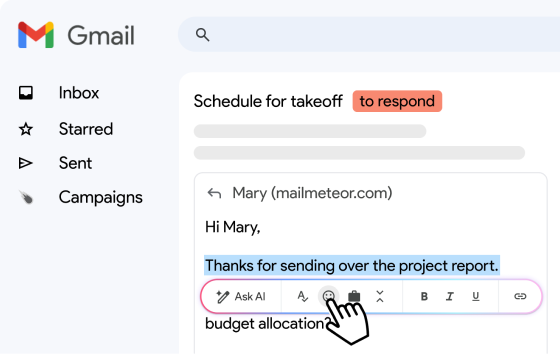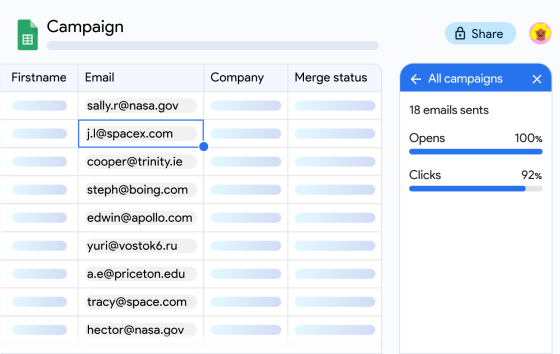Lead generation is one of the most lucrative activities in B2B marketing. It is the lifeblood of any successful business, because without a steady flow of leads, your sales funnel quickly runs dry.
So, getting new leads to fill your sales funnel is important for both growth and sustainability, right? But what exactly do you need to do so? This guide will teach you everything there is to know about B2B Lead Generation, so let us begin because there is a lot of ground to cover, as we will go over:
- What is Lead Generation?
- Key Steps of B2B Lead Generation
- Picking a B2B Lead Generation Method
- Outbound B2B Lead Generation Strategies
- Inbound B2B Lead Generation Strategies
- Picking a Strategy for Your Business
As usual, first things first:
What is Lead Generation?
The process of identifying and attracting potential customers for your business is called lead generation. Imagine you have a physical store, everything from your storefront banner to the pamphlets you hand out will contribute to your lead generation efforts.
This is true for the digital landscape too! We use different strategies, capture interest, and collect information from potential clients to offer a better sales pitch when we reach out to them.
In the B2B world, this means engaging with other businesses to convert them into loyal customers. Properly employing a lead generation strategy will not only increase your sales opportunities but also improve your brand’s organic visibility and reputation across the board.
But how exactly is B2B Lead Generation different from its B2C counterpart?
B2B Lead Generation vs B2C Lead Generation
While the core methodologies between B2B & B2C strategies remain the same, there is a vast difference between both worlds. Understanding these differences can help tailor your strategies for maximum effectiveness in the B2B landscape, especially if you already have some experience in B2C sales.
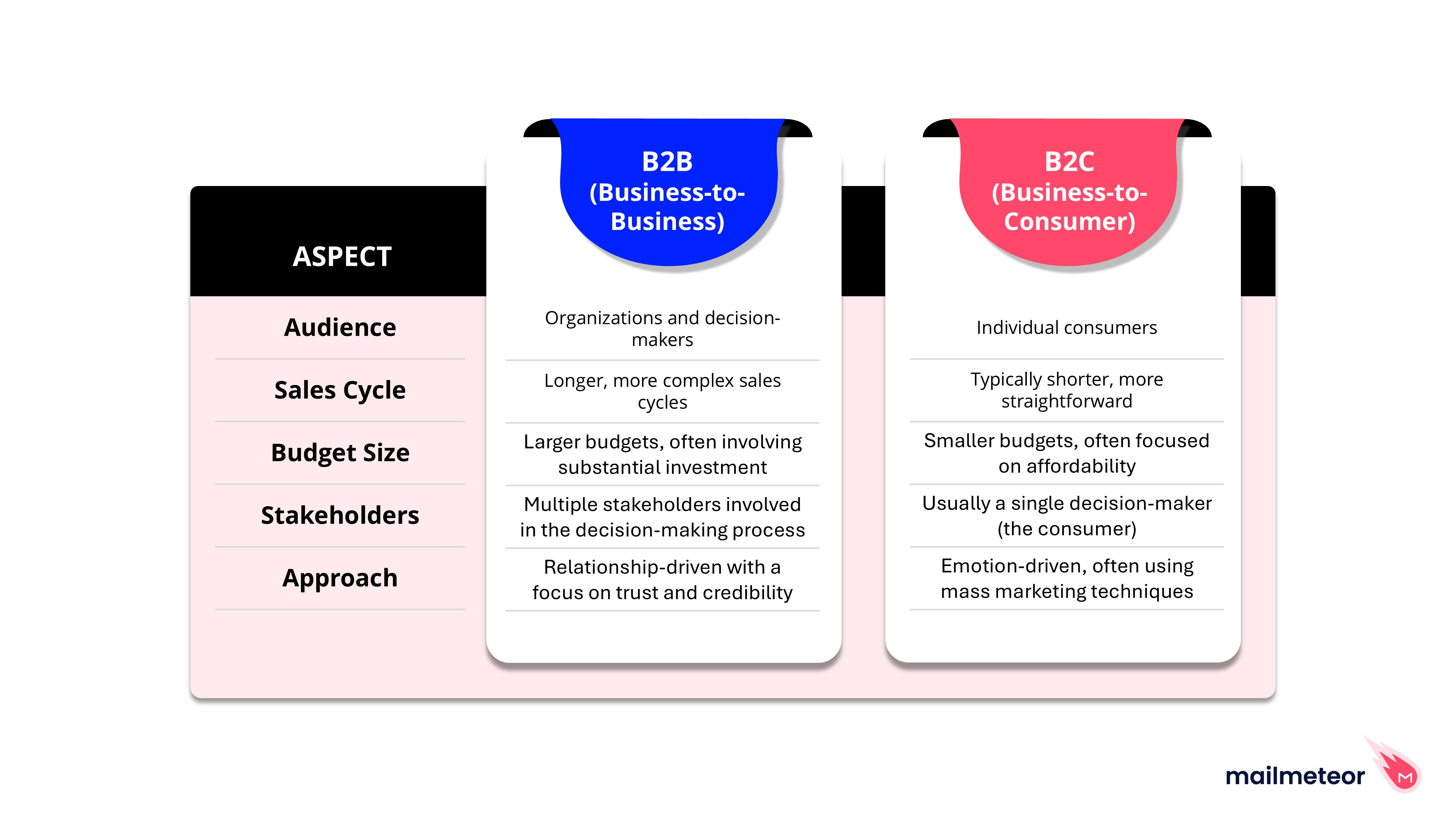
Understand the difference? Let us now look at how you can measure your success in B2B Lead Generation.
Measuring Success in B2B Lead Generation (KPIs)
To determine how well your lead generation efforts are performing, we need to track some key performance indicators (KPIs). These KPIs provide valuable insights into your strategies and help you understand where you can improve; remember, you can only improve something if you measure it!
Here are some important KPIs to consider:
- Conversion Rate: Say you got a hundred leads, but only 5 end up converting. Your conversion rate is therefore 5%. A higher conversion rate indicates that your lead generation efforts are doing their magic.
- Cost Per Lead (CPL): Calculate how much it costs to earn yourself a single lead. Keeping this number low while maintaining lead quality is crucial for profitability.
- Cost Per Acquisition (CPA): How much it costs to acquire a single sale, you can calculate this number easily if you have your conversion rate and cost per lead figured out.
- Return on Investment (ROI): Measure the total revenue generated from your lead generation efforts against the total costs. A positive ROI means your strategies are paying off and you can scale up.
Got these covered? Here are some more advanced ones you can work on, because they are more difficult to measure and improve!
- Lead Quality: Assign a score to your leads based on their engagement and willingness to buy. High-quality leads are more likely to convert into sales.
- Lead Source Effectiveness: Identify which channels generate the most leads, also identify the effectiveness of your own scoring strategies. If you notice that low quality leads are converting despite your predictions, you need to redo your homework!
- Lead Nurturing Time: Track how long it takes for your sales team to convert a lead into a customer, then try and improve this metric. Shorter nurturing times indicate that your leads are high quality and that building a trustworthy relationship is easy for your sales team.
Keep a close eye on these KPIs as you refine your lead generation strategies to drive greater success & revenue for your business.
Key Steps of B2B Lead Generation
Your aim with B2B Lead Generation is to attract potential clients, but not just any clients! Your aim is to bring in high quality leads that are easy to nurture and convert for your sales team. Doing so is not an easy ask; you will need to cast a wide net at first and then refine your strategy as you collect more data.
So, without wasting any more time, here are the key steps involved in the B2B Lead Generation process, and what you can do to improve your results.
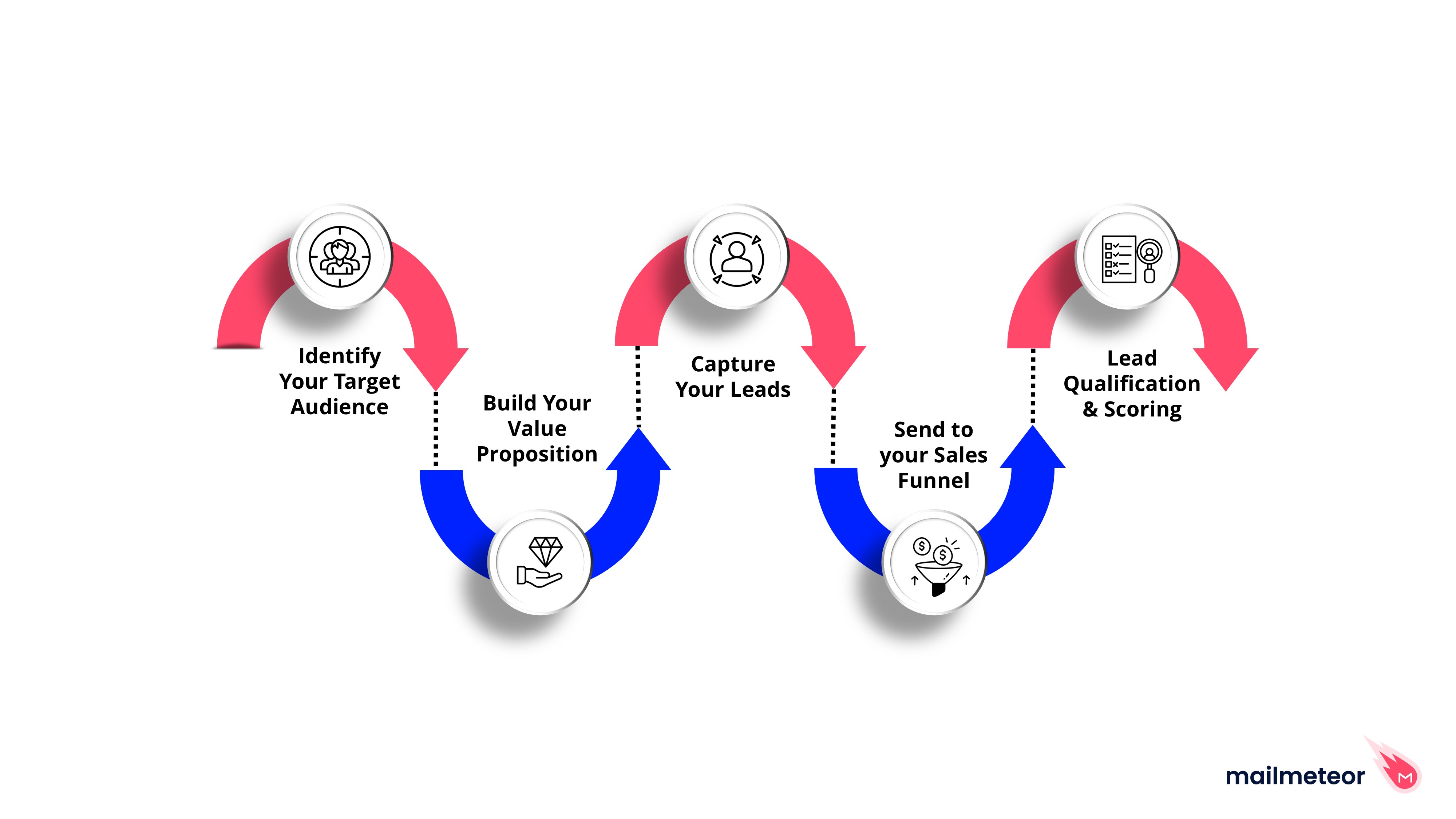
Target Audience Identification
Identifying your target audience is a foundational step in the B2B lead generation process.
You try and understand who your ideal customers are; then you focus on their pain points, preferences, and behaviors. This step demands thorough market research so that you can create detailed buyer personas which guide your marketing efforts and ensure that you attract the right prospects.
Here is what you can do to improve your odds of identifying the right target audience:
- Market Research: Take advantage of surveys and interviews to gain insight into your audience’s needs, talk with existing customers, discuss details with ideal ones.
- Social Media Analytics: Analyze user engagement metrics across your social media content to understand who is responding to it, who interacts with it, and which demographic resonates the most with your brand.
- Audience Segmentation: Use your collected data to identify different demographics which you can target with distinct methods. Young clients might resonate more with trendy content while elder executives demand a more serious tone, segmentation is a lifesaver in these scenarios.
- Monitor Competitors: Sign up for your competitor’s newsletters and keep yourself up to date on their marketing strategies. This will let you identify potential gaps in your own efforts which you can quickly fill.
Mastering the art of effectively identifying your target audience can streamline your marketing efforts and ensure that you only connect with prospects who are likely to show an interest in your services and are therefore easier to convert into customers.
Build a Compelling Value Proposition
You need to offer raw value to attract businesses to your cause – and businesses across the world speak the language of profit.
A compelling value proposition conveys the unique benefits that your product or service can offer to your intended customer. Ideally, it would differentiate your business from the competition and address a specific need or pain point that your customers struggle with.
Need some help with building your value proposition? Keep these strategies in mind:
- Focus on Benefits, Not Features: Highlight how your solution can make the customer’s business money, solve their problems, or save on costs.
- Use Clear Language: Avoid technical jargon or niche-specific jargon. Always communicate your value in simple terms.
- Customer Testimonials: Did you help a former client cut their costs massively? Take advantage of this social proof, use it to build credibility, while establishing trust at the same time.
It is difficult to craft a short, concise, and unique value proposition. But once you do so, it will set the stage for all your future interactions and prep your leads for a sale before they even reach out to your sales team.
Capturing Your Leads
You have decided on the bait, you have the ideal catch in mind, now it is time to cast the net and catch some fish.
In order to capture leads, you need to create opportunities for potential customers to express their interest in your offer. This step is crucial, otherwise you will not be getting any leads at all!
We will discuss the exact lead capture methods available to you later in this guide as we tackle inbound and outbound lead generation methods separately, but to optimize your lead capture efforts, consider the following:
- Offer Value: Provide valuable content such as informative blog posts, e-books, case studies, or just an interesting webinar in exchange for contact information.
- Clear Calls-to-Action (CTAs): Make sure that your landing pages and content have prominent and persuasive CTAs, leave no visitor confused.
- A/B Tests: Keep experimenting with different designs and copy-variants to determine what strategy resonates the best with your potential leads.
Capturing leads successfully is the entire purpose of this guide! In the next section we will discuss the exact methods you can use to do so. For now, let us continue to the next step of lead generation.
Lead Qualification & Scoring
How do you know which leads are worth prioritizing and which ones you can safely abandon? Lead qualification is the process of scoring leads based on their potential value and likelihood of converting.
This stage involves evaluating leads against predefined criteria which aligns with your ideal customer profile and your business goals. Properly qualifying a lead is important if you wish to scale up your lead generation efforts!
- Objective Scoring: Use objective metrics like response time, budget, and readiness to buy to assign lead scores.
- Automate with CRM Tools: Take advantage of customer relationship management software to automate and streamline your scoring process.
- Analyze Historical Data: Develop a scoring system that fits with your past customer interactions as well and survives some back-testing.
- Iterate & Improve: Continuously assess and analyze the performance of your scoring system to refine and improve as the market changes.
The next step after qualification would be nurturing your leads, but we are now trespassing into the territory of your sales team and their cherished sales pipeline, so let us back off a little and discuss the different lead generation methods available for you to pick from.
Picking a B2B Lead Generation Method
As you explore the options available to you, it is important to consider the specific needs of your business, who your target audience is, and what resources are available at your disposal.
There are two main categories that you can break down all lead generation methods into: outbound and inbound lead generation.
B2B: Outbound vs Inbound Lead Generation
Each approach has its strengths and weaknesses, so understanding these can help you choose the best strategy for your business. Let us analyze the pros and cons of these two categories so you can develop a clearer understanding of which approach aligns best with your business goals.
Outbound Lead Generation
Outbound lead generation focuses on actively reaching out to potential prospects. This can include cold calling, direct emails, and even in-person networking at events.
The key characteristic of outbound is that you initiate the conversation!
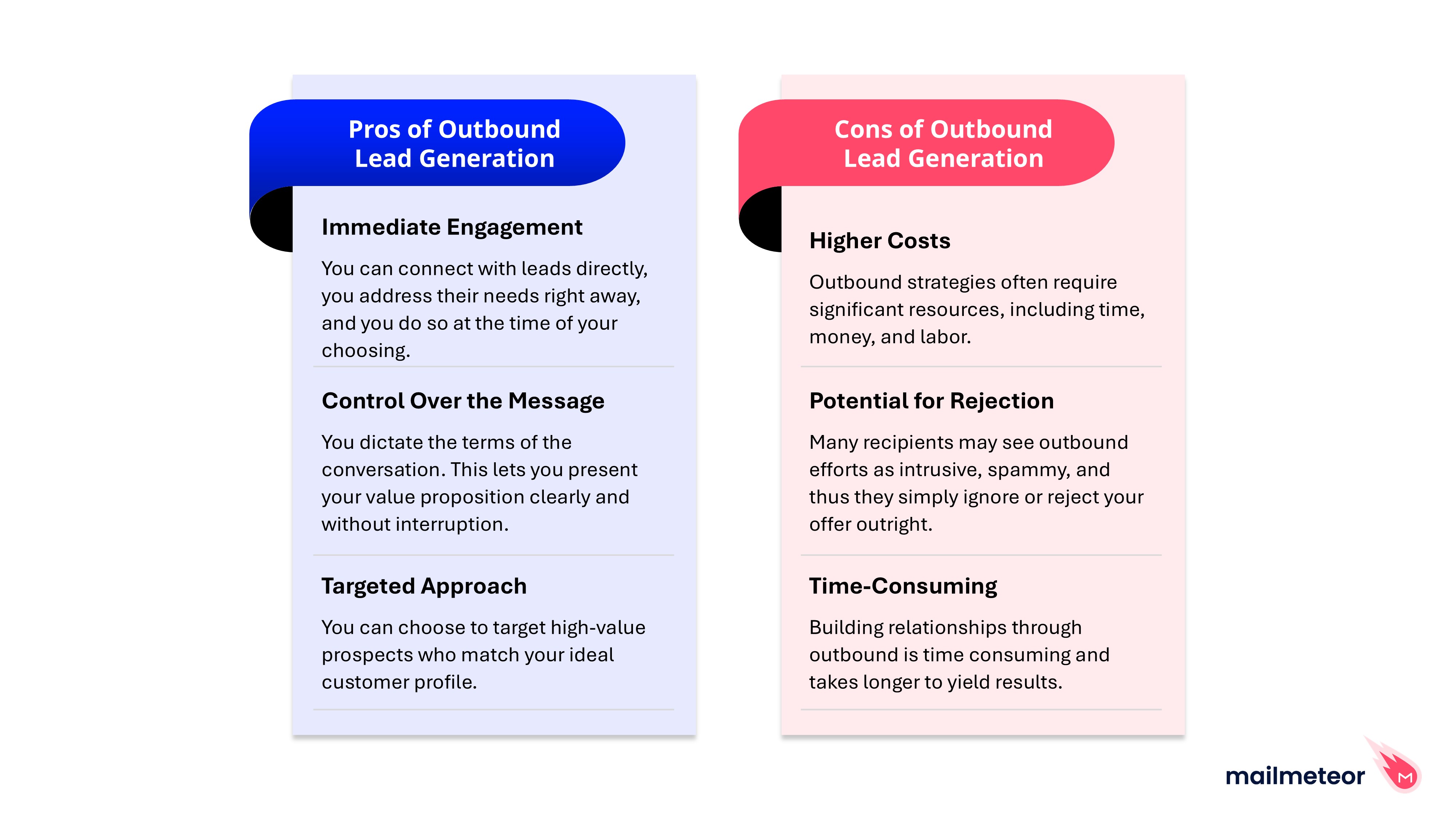
Inbound Lead Generation
Inbound lead generation focuses on attracting potential customers to you. Businesses that follow this strategy rely on content marketing, SEO, social media, etc. to bring in the leads.
The goal is to provide value first, then you encourage prospects to engage with your brand.

Outbound B2B Lead Generation Strategies
Outbound lead generation strategies involve proactively reaching out to potential clients or customers to generate interest in products or services.
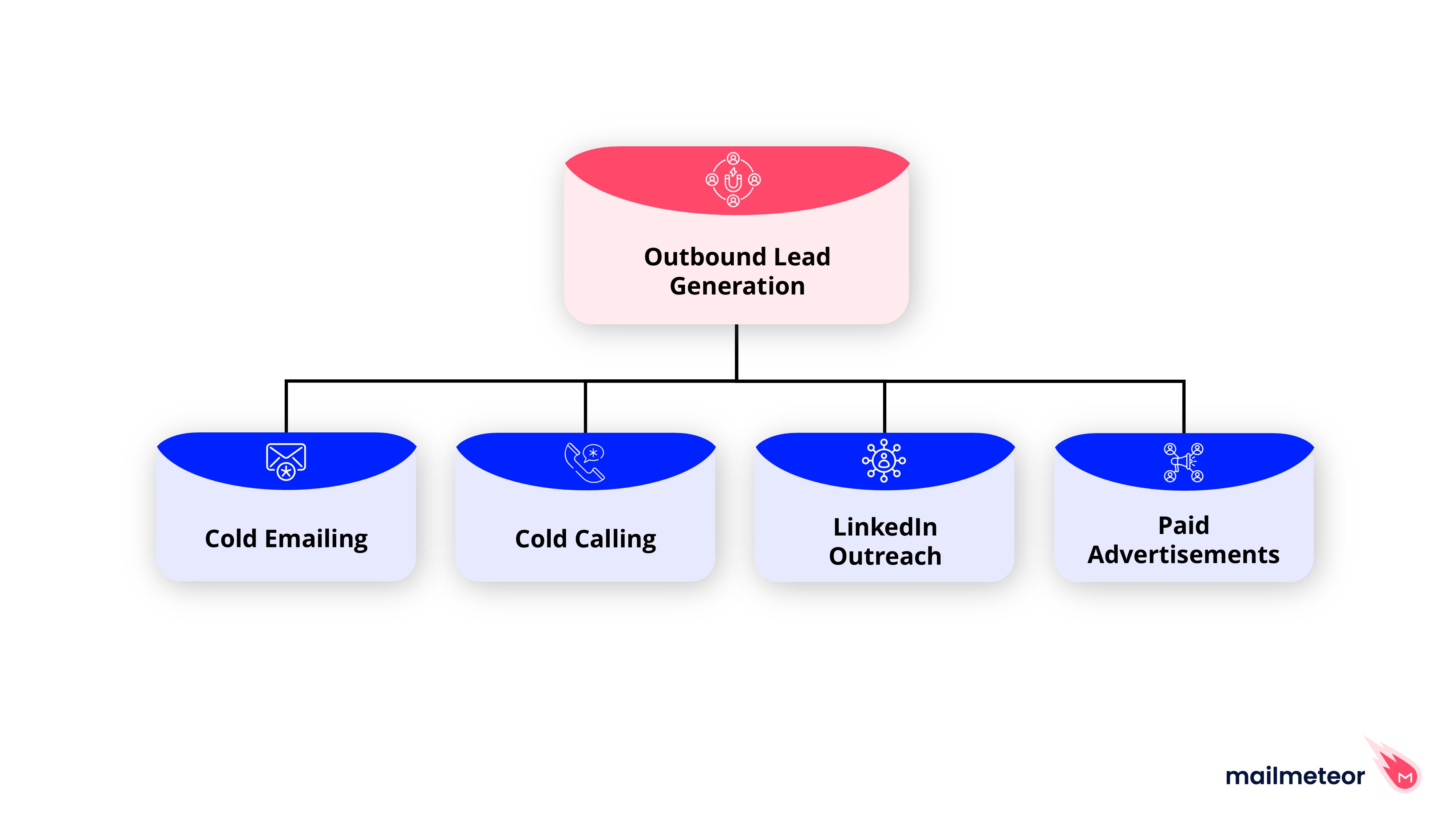
outreach methods which have fallen off in the B2C world remain relevant for creating meaningful connections and nurturing leads in the B2B space.
Cold Emailing
Cold emailing is the most popular type of outbound lead generation, it is the process of sending emails to potential clients in order to introduce your products or services.
This strategy is particularly effective for B2B lead generation, as it lets you precisely target your ideal customers, and you can easily customize the contents of an email to address the recipient’s challenges directly.
Well-crafted cold emails pique interest, start a conversation, and finish it all off by encouraging the recipient to take actionable steps, also known as a call to action (CTA).
- Common actionable steps include scheduling a meeting, attending an event or webinar, or simply just replying with a request for more information.
- Cold emails are incredibly scalable, and you can quickly start reaching out to as many prospects as you like once you have the core email sequence figured out.
Thanks to email marketing tools and the ability to create email sequences, you can automate almost every aspect of cold emailing, from the initial introductory email to your follow ups and reminders. These tools also help you collect valuable metrics, letting you run A/B testing to find out the best strategy for your lead generation efforts.
Cold Calling
Cold Calling involves directly reaching out to potential clients via a phone call to introduce yourself, and your services. This approach is more effective in the service industry where it is easier to identify prospects who need your service.
Thorough preparation, research, and a ton of quick-thinking are essential for successful cold calling adventures!
- Just like cold emailing, by the end of the call your recipient should know about the next actional steps they can take to move things along.
- Phone calls are far more effective at establishing rapport and trust compared to a cold email, skilled marketers can close deals and build long term relationships like no tomorrow.
- Any questions or potential objections are addressed as they are brought up by the prospects, this immediate feedback is what makes cold calling such a rewarding strategy.
Unfortunately, cold calling is as difficult as it is rewarding. Sales representatives who are good at cold calling are worth their weight in gold, and the icing on top is the fact that a single human being can only dedicate themselves to a single call at a time. Making cold calling incredibly expensive to scale and ramp up.
LinkedIn Outreach
As a social networking platform for professionals, LinkedIn provides a unique opportunity for you to connect with business decision-makers and industry influencers. By taking advantage of their advanced search features, and the ability to target specific industries, roles, or companies through their advertisement campaigns, sales professionals can identify and engage with potential clients more effectively than through purely cold outreach methods.
- LinkedIn lets you build rapport quickly since your public profile and its contents can build both credibility and trust.
- Depending on your niche, LinkedIn may or not be the best social media platform for you to focus on, make sure you do your research before diving in!
The problem with LinkedIn outreach is that it you are not the only one doing it – it is quite common for anyone with any influence to have an inbox full of unsolicited messages, invites, and connection requests. It is far better to have an initial introduction elsewhere before attempting cold outreach with a party on LinkedIn.
Paid Advertisements
Businesses looking for a direct and scalable method to reach their target audience across a variety of platforms will find paid advertisements as their go-to choice. By taking advantage of powerful targeted advertisement tools that social media platforms provide you, such as audience segmentation and retargeting campaigns, marketers can set up targeted campaigns designed to convert potential leads into customers. Often times more efficient than organic methods.
- Paid ads let you achieve measurable results quickly, metrics such as click-through rates (CTR), impressions, and conversion rates are easy to understand and help you optimize campaigns in real time.
- Platforms like Google Ads excel for search intent, while Facebook and Instagram offer powerful tools for visual storytelling and audience engagement, pick your poison wisely!
But paid advertisements are not without their drawbacks. Cost, competition, and saturation. Consumers are often overwhelmed with ads, which can lead to ad fatigue. At the same time, without a clear strategy and well-defined goals, it is extremely easy to spend a lot of money without seeing significant returns.
A strong understanding of your audience and a clear value proposition are important to ensure that your ads resonate and stand out in a competitive marketplace.
Other Outbound Strategies
In addition to the strategies mentioned above, there are some other remarkably effective strategies that we wish we could go into the details of:
- Attending Webinars and Virtual Events
- Networking at Industry Conferences
- Influencer Marketing
- Multichannel Outreach
- Contests & Giveaways
- Affiliate Marketing
Inbound B2B Lead Generation Strategies
Inbound lead generation strategies focus on providing value to the general public, focusing on details that your ideal customers might be interested in, and then prompting them with a call-to-action to reach out to you for your services or product.
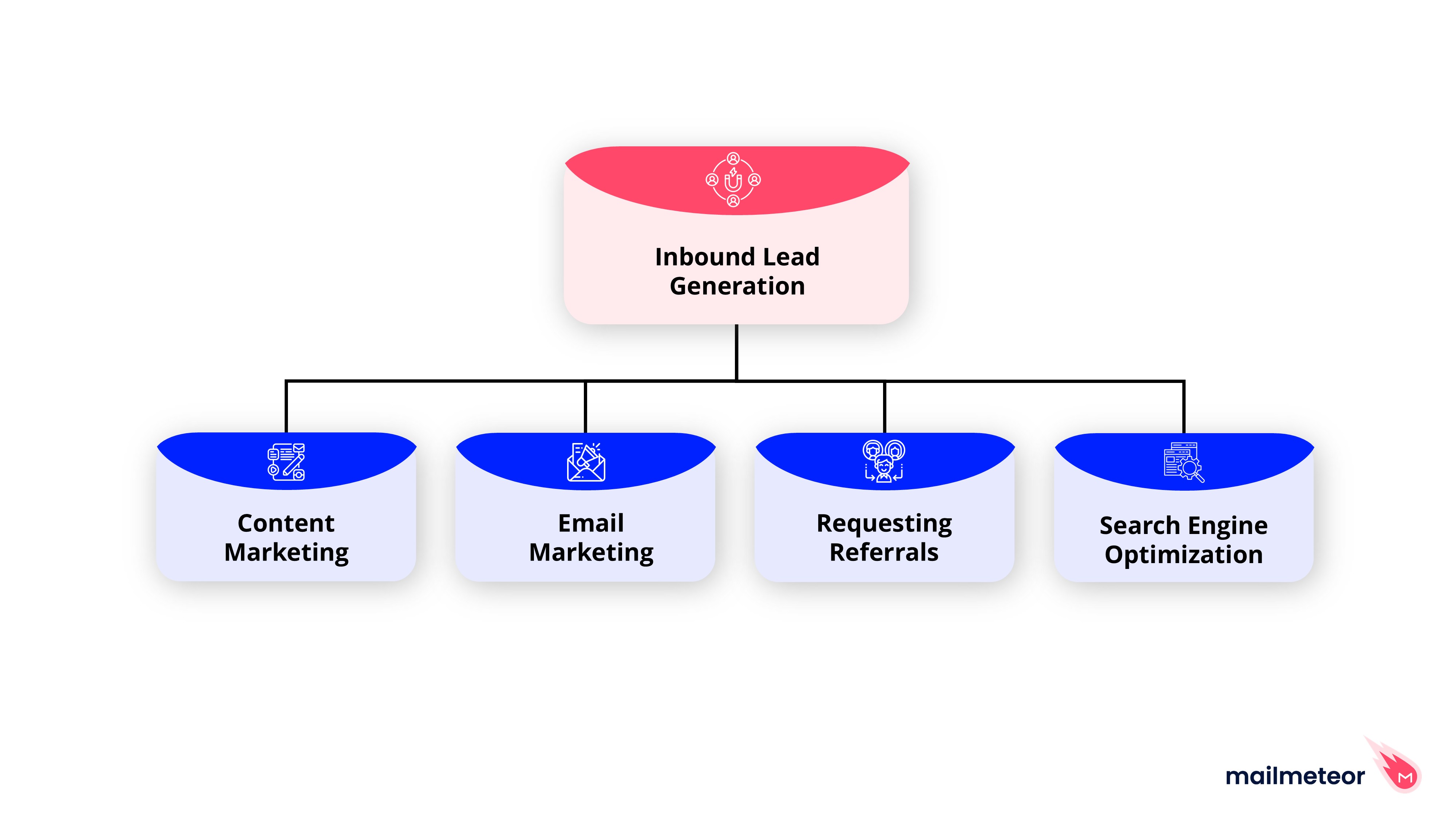
In simple words, a lead is considered inbound if the lead itself is starting the conversation with your business for your services.
Content Marketing
Content marketing is a cornerstone of inbound lead generation strategies. You focus on the creation and distribution of valuable, relevant content aimed at attracting and engaging a target audience.
Instead of pushing sales messages, businesses use informative blog posts, case studies, eBooks, videos, and infographics to educate potential customers while also providing solutions to their challenges. Why? To build trust and position yourself as a thought leader of course.
- Content marketing is key for building organic relationships, where your leads reach out to you for your services when they become ready for a purchase decision.
- With proper planning, you can customize and redistribute your content across different platforms and social media networks. Maximizing your reach and engagement with relatively low additional effort.
Do you know what content marketing helps with the most? Your search presence and brand authority. We will discuss the importance of search presence when we discuss SEO as a strategy; but the reason brand authority is important for inbound lead generation is because people are more likely to opt for a service from you if there is social proof backing up your offer.
Nothing builds social proof better than a well-executed content marketing campaign! People love free stuff, and experts who share their knowledge for free are loved even more.
Email Marketing
You can give your Content Marketing efforts a helping hand by requesting an email address from your visitors in exchange for some goodies. This can be free a guide, an eBook, subscription to a newsletter, or just some secret recipe sauce. This lets your visitors enter the sales funnel more naturally, warming them up for eventual conversion, and opening the door for Email Marketing.
Email Marketing revolves around building a list of subscribers to share valuable content, offers, and updates directly with. This strategy improves customer engagement and nurtures leads by delivering tailored messages to specific segments of the audience. Email campaigns can include all sorts of newsletters, exclusive offers, educational content, or simple product updates.
- A key detail of a well-designed email campaign is to ensure that you provide value in every email sent from your end. This ensures that readers stay engaged and it increases the likelihood of them converting when the time is right.
- Most email marketing tools let you personalize and automate your entire email marketing setup, plus; audience segmentation makes it possible for you to tailor your content according to each recipient.
If you are looking for a marketing strategy that you can fully automate and optimize to your heart’s desire, email marketing is the way to go.
Requesting Referrals
Requesting referrals from your existing clientele is a time-tested strategy that generates very high-quality leads. Because you are leveraging existing clients & contacts to introduce new prospects to the business, you are also capitalizing on the trust and credibility established with these existing clients.
- Referrals yield higher conversion rates than traditional cold outreach methods, as referred leads typically come with a built-in sense of trust and validation.
- Happy clients do not think twice before sharing their positive experiences, making referrals a natural extension of excellent customer service and a healthy relationship.
Consistently nurture your relationships with existing and past customers, show appreciation for referrals, and deliver an excellent service. Doing so will create a virtuous cycle of lead generation that continues to feed the sales pipeline long after you finish working with someone.
Search Engine Optimization (SEO)
Search Engine Optimization is the utmost pillar of inbound lead generation. It focuses on improving your website’s visibility on search engines like Google, well, let us be honest, just Google.
Your aim? To ensure that your target audience discovers your content when they search for relevant topics or services. The goal is simple: rank higher on the search engine result pages (SERPs) and drive organic traffic that costs you nothing in the long run.
- SEO is a game-changer for organic traffic. When implemented properly, it drives long-term traffic, reducing your dependency on paid ads. It is a cost-effective way to attract quality leads who are actively searching for your products or services.
- With the right strategy, SEO works in-tandem with other inbound methods, especially content marketing. You can repurpose your blog posts, videos, or infographics to rank for high-value search terms across multiple platforms.
Here is the best part: SEO improves your brand’s credibility and trust at the same time. Potential customers view high rankings on Google as a badge of approval. After all, it has to be trustworthy if Google has put it on the first page, right?
Picking a Strategy for Your Business
Selecting the right lead generation strategy for your business requires a clear understanding of what you hope to achieve, your target audience, and of course the resources available to you.
Here’s a quick guide to help you make an informed choice:
- Understand Your Audience: You should tailor your strategy based on your target market and industry. Some demographics respond better to direct outreach methods like cold emailing or calls, while others will end up engaging more with high quality content.
- Consider Your Budget: If you are working with limited resources, cold emailing, cold calling, and LinkedIn outreach are the tedious but cost-effective options available to you. Paid advertisements and SEO on the other hand are incredibly effective but demand a larger budget for optimal results.
- Scalability and Automation: If scalability is a priority, use tools that can help you automate outreach and lead nurturing. Email marketing platforms and CRM tools are a prime example. For a more personalized outreach, opt for cold calling and LinkedIn where you can ensure a more hands-on experience.
- Time to Results: If you need leads quickly, paid ads or direct outreach methods like cold calling will give you faster results. On the other hand, content marketing and SEO are long-term strategies that can build a sustainable flow of leads over time.
But there is no one-size-fits-all solution for most businesses out there. Your ideal B2B lead generation strategy is probably going to be a mixture of multiple inbound and outbound strategies.
We hope this guide was helpful and wish you success in your lead-gen adventures!

